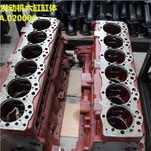Vibratory rollers have two additional variables that the operator must control during the compaction process. The first is the frequency of the vibration. Most vibratory rollers have a range of vibratory frequencies available.
With very few exceptions, the maximum possible frequency setting available should be chosen. This permits the roller to maximize the amount of compactive effort applied to the mix by minimizing the spacing between impacts.
Frequency is measured in terms of vibrations per minute (vpm). At the same roller speed, a vibratory roller operated at a frequency of 2,400 vpm will provide more impacts per foot than will the same roller operated at a frequency of 2,000 vpm.
More impacts per foot provides more compactive effort for each pass of the roller. Frequency of vibration, in conjunction with roller speed, plays a very significant role in the ability of the vibratory roller to efficiently obtain density in the HMA material.
The amplitude setting (impact height) on a vibratory roller depends on the thickness of the layer being compacted. For the vast majority of mixes placed, the roller should be operated at the lowest amplitude setting. Only when the lift thickness is greater than about 3 in. should the use of a higher amplitude setting be considered.
The amplitude setting also is dependent, in part, on the characteristics of the mix. If the mix is tender, only the lowest amplitude setting should be used. If the HMA is stiff and stable, and the lift thickness is at least 21¦2 in., use of a higher amplitude may be possible. A high amplitude setting on a thin lift (less than 2 in.) will typically cause the vibratory roller to bounce, making it very difficult to obtain the desired density level.
For very thin lifts, 1 in. or less in thickness, the vibratory roller should not be used in the vibratory mode. Instead, operate the unit in the static mode.
The compaction of an asphalt-concrete mix is really common sense. Because density, or its inverse air-void content, is the single most important variable affecting the long-term durability of an HMA material, it is very important that proper attention is applied to those primary factors that affect the time available to compact the mix-air temperature, base temperature, mix laydown temperature, layer thickness and wind velocity.
In addition, the five main variables that can be controlled by the roller operator during the compaction process should also be carefully monitored-roller speed, number of roller passes, rolling zone, rolling pattern and vibration frequency and amplitude.
The proper air-void content in the mix must be obtained at the time of construction in order to prevent the mix from failing prematurely under the applied traffic loads.








